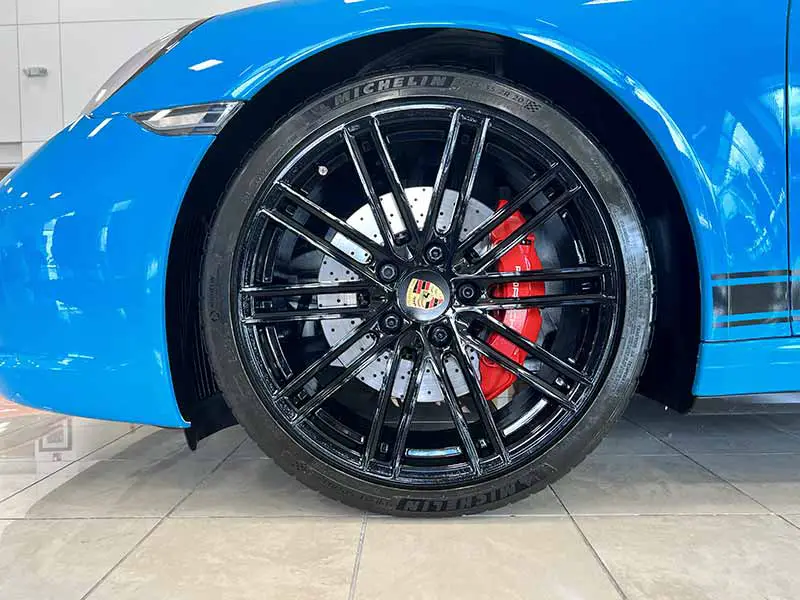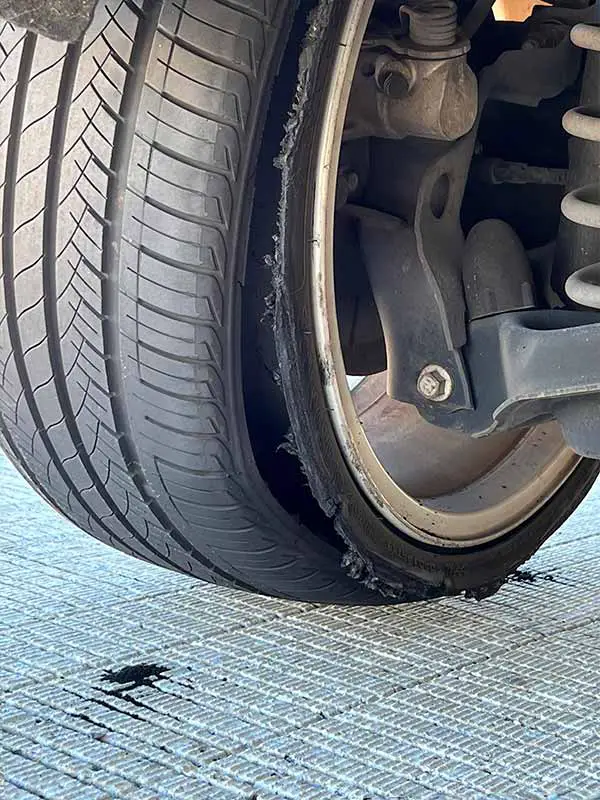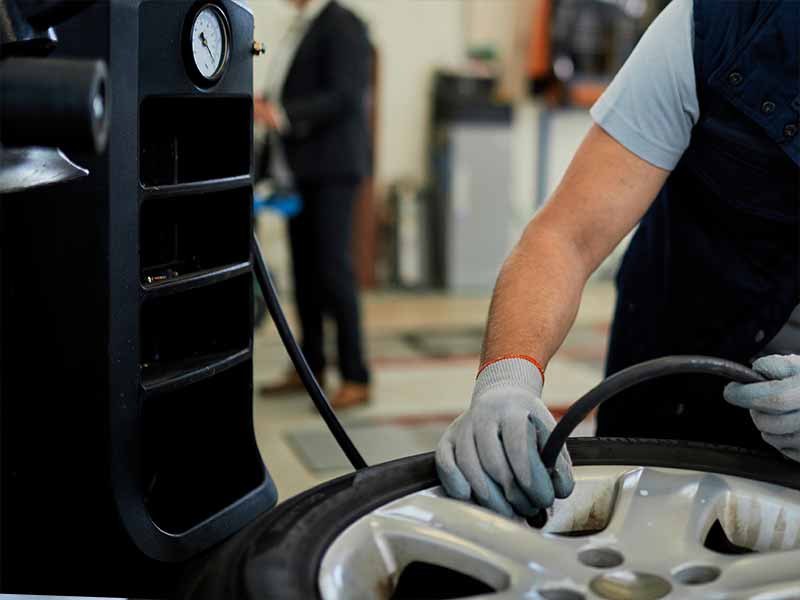You’re driving along, listening to your favorite song, when suddenly a little icon on your dashboard lights up – it’s the low tire pressure warning. Your heart sinks as you wonder what this means for your journey. But, don’t panic! Understanding your vehicle’s tire pressure isn’t as scary as it sounds and knowing what to do could save you from unnecessary worries, or even a potential accident.
What Happens If Tire Pressure Is Too Low?
If your tire pressure is too low, it can lead to issues like reduced fuel economy, harder steering, increased tire wear, and even a higher risk of tire blowouts.
It’s important to maintain the recommended tire pressure for your vehicle to ensure optimal performance and safety.
In this article, we’ll take a deep dive into tire pressure. We’ll discuss what it is, the effects of having too low tire pressure, how to identify low tire pressure, the risks of driving with low tire pressure, and how to maintain the correct tire pressure.
Let’s take a closer look.

Understanding Tire Pressure
Understanding tire pressure can seem a little tricky, but let’s break it down so it’s as simple as pie.
What is Tire Pressure?
First, let’s start with what tire pressure actually is. Tire pressure, in the simplest terms, is the amount of air inside your tire. It’s usually measured in pounds per square inch (PSI). Think of your tire as a small air balloon. When you inflate it, you’re actually increasing the air pressure inside.
Low Tire Pressure: What Does It Mean?
Now, what do we mean when we talk about low tire pressure? Well, each vehicle has a recommended tire pressure level set by the manufacturer. This information is usually found on a sticker inside the driver’s side door jamb or in the vehicle’s owner’s manual. If the amount of air in your tires is below this recommended level, then your tire pressure is considered low.
Tire Pressure Monitoring System: Your Car’s Handy Tool
Your vehicle comes equipped with a nifty feature called a Tire Pressure Monitoring System (TPMS). This system keeps an eye on your tire pressure and alerts you when it drops below the safe level. It’s like having a mini tire expert right in your dashboard! When the tire pressure gets too low, the TPMS will turn on a warning light on your dashboard (usually looking like an exclamation mark inside a horseshoe shape) to let you know it’s time to inflate your tires.
Getting Hands-on: Using a Tire Pressure Gauge
And what if you want to check the tire pressure yourself? That’s where a tire pressure gauge comes in. Here’s how you can use it:
- Remove the cap from your tire’s valve stem. It’s the little protruding thing you use to inflate your tires.
- Press the tire pressure gauge onto the valve stem. Make sure it’s tight so no air escapes.
- Read the tire pressure on the gauge. It will display the PSI level of your tire.
Checking your tire pressure regularly with a tire pressure gauge can help you maintain proper tire inflation, ensuring a smooth and safe ride.

Effects of Low Tire Pressure
Alright, now that we’ve got the basics of tire pressure down, let’s get into the nitty-gritty of what happens when your tire pressure is low. Low tire pressure may seem like a small thing, but it can have a pretty big impact on your vehicle.
Impact on Tire Performance
First off, let’s talk about your tire performance. You might be thinking, “what’s a little air got to do with how my tires perform?” Well, more than you might expect!
- Traction: Underinflated tires, or tires with too low pressure, can mess with your vehicle’s traction. This means your car might not respond as well when you steer or brake, especially on wet roads. Yikes!
- Tire Wear: Underinflated tires also wear out more quickly and unevenly. The tires can’t distribute your car’s weight evenly across the tire’s surface, which makes some parts wear out before others.
- Heat Build-up: When a tire is underinflated, more of its surface touches the road. This leads to more friction, which makes your tires heat up. Over time, this can lead to tire failure, and no one wants that!
Low Tire Pressure and Gas Mileage
Low tire pressure doesn’t just affect your tires; it can hit your wallet, too! When your tires are underinflated, your car uses more energy to move, which means it uses more gas. It’s kind of like trying to ride a bike with a flat tire – it’s way harder to pedal, right? The same goes for your car. The Department of Energy estimates that properly inflated tires can improve your gas mileage by up to 3%.
Air Temperature and Tire Pressure: An Interesting Relationship
One more thing to keep in mind is that your tire pressure can change with the weather. When it gets cold, air contracts, and your tire pressure can drop. It’s not unusual for the low tire pressure light to come on the first chilly morning of the fall. But don’t worry – driving a short distance or letting the tires sit in the sun will often bring the pressure back up.

Identifying Low Tire Pressure
So we’ve talked about what tire pressure is and what happens when it’s too low. Now, let’s dive into how you can identify if your tire pressure is low. Paying attention to these signs can help you stay safe on the road and keep your vehicle in good condition.
The Feel of Low Tire Pressure
The first sign that your tire pressure might be low is a change in how your car drives. If your vehicle isn’t handling quite right, it could be a sign of low tire pressure. Here’s what you might notice:
- Hard Steering: Does your car feel a little stubborn when you try to steer? Low tire pressure can make steering feel harder than usual.
- Pulling: If your car seems to be pulling to one side, one of your tires could be low on air.
- Bumpy Ride: A car with low tire pressure can give you a ride that’s less smooth than usual. If you feel like you’re feeling every bump in the road, your tire pressure could be too low.
Remember, these signs can also indicate other issues with your vehicle, so if you notice them, it’s a good idea to get your car checked out.
The Low Tire Pressure Warning Light
Your vehicle is equipped with a Tire Pressure Monitoring System (TPMS) that warns you when your tire pressure is too low. When your tire pressure drops significantly, this system triggers the low tire pressure warning light on your dashboard. This light usually looks like an exclamation point inside a flat tire and is a surefire sign that at least one of your tires is underinflated.
When you see this light, don’t panic! It’s not an immediate emergency, but you should make a plan to check your tire pressure and inflate your tires as soon as it’s safe and convenient.

Risks of Driving with Low Tire Pressure
We’ve touched on the signs and impacts of low tire pressure, but it’s crucial to know the risks of actually hitting the road with underinflated tires.
How Long Can You Drive with Low Tire Pressure?
You might be wondering, “How long can I drive with low tire pressure?” While driving a short distance with low tire pressure probably won’t cause immediate damage, it’s not a good idea to ignore the problem for too long. Prolonged driving on underinflated tires can lead to the issues we discussed earlier, like uneven tire wear and increased fuel consumption, not to mention the risk of tire failure. So, if you notice your tire pressure is low, try to fill your tires as soon as you can.
The Dangers of Low Tire Pressure
Let’s get into the serious stuff. Driving with low tire pressure isn’t just bad for your vehicle; it can also be dangerous. Here’s why:
- Tire Blowouts: When your tire pressure is too low, more of the tire’s surface area touches the road. This creates more friction and heat, which can lead to a tire blowout. A blowout is when your tire suddenly loses all of its air, usually while you’re driving. As you can imagine, this can be pretty dangerous, especially at high speeds.
- Decreased Handling: Underinflated tires can make your vehicle harder to handle. Your car might not respond as well when you steer or brake, which can be especially problematic in an emergency situation or bad weather.
- Flat Tires: Driving on a severely underinflated tire can damage the tire’s structure to the point that it can’t hold air anymore. This can leave you with a flat tire, and no one wants to deal with changing a tire on the side of the road.
Resources
Below are some links you may find helpful when learning about tires
- You should never let your tires get low – Car and Driver
- How low is too low for tire pressure – J.D. Power
Final Thoughts
Driving with low tire pressure can lead to reduced fuel economy, increased tire wear, harder steering, and a higher risk of tire blowouts.
Fortunately, keeping your tire pressure in check isn’t as daunting as it might seem. By paying attention to the warning signs, regularly checking your tire pressure with a simple gauge, and seeking timely tire service, you can avoid these problems.
Good luck and happy motoring.





